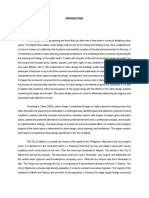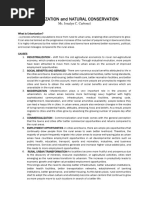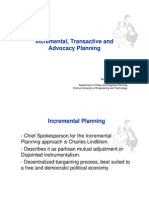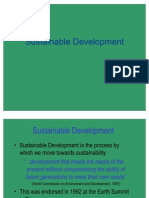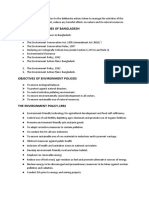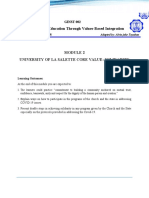Environmental Impact Assessment
Environmental Impact Assessment
Uploaded by
shrutiCopyright:
Available Formats
Environmental Impact Assessment
Environmental Impact Assessment
Uploaded by
shrutiOriginal Description:
Original Title
Copyright
Available Formats
Share this document
Did you find this document useful?
Is this content inappropriate?
Copyright:
Available Formats
Environmental Impact Assessment
Environmental Impact Assessment
Uploaded by
shrutiCopyright:
Available Formats
http://www.unescap.org/drpad/vc/orientation/m8_1.htm http://www.miga.org/documents/EIA_Takoradi.
Environmental Impact Assessment Principles and Process
Figure 1: EIA concept and eight guiding principles
The eight guiding principles...
There are eight guilding principles that govern the entire process of EIA and they are as follows: Participation: An appropriate and timely access to the process for all interested parties. Transparency: All assessment decisions and their basis should be open and accessible. Certainty: The process and timing of the assessment should be agreed in advanced and followed by all participants. Accountability: The decision-makers are responsible to all parties for their action and decisions under the assessment process.
Credibility: Assessment is undertaken with professionalism and objectivity. Cost-effectiveness: The assessment process and environmental protection at the least cost to the society. its outcomes will ensure
Flexibility: The assessment process should be able to adapt to deal efficiently with any proposal and decision making situation. Practicality: The information and outputs provided by the assessment process are readily usable in decision making and planning.
Applying EIA...
EIA is considered as a project management tool for collecting and analyzing information on the environmental effects of a project. As such, it is used to: identify potential environmental impacts, examine the significance of environmental implications, assess whether impacts can be mitigated, recommend preventive and corrective mitigating measures, inform decision makers and concerned parties about the environmental implications, and advise whether development should go ahead.
EIA Process...
In EIA systems there are sequence of activities implemented in project in a logical sequence and are termed as EIA process. They are given in Figure 2. Figure 2: The EIA processes in sequences of application.
Project screening Not all development projects require EIA. Project screening will help identify the ones that actually do. Here in this section describes the various screening criteria. Scoping The process of scoping helps determine the coverage or 'scope' of the EIA. The methods of scoping is elaborated in this section. Baseline data collection A brief explanation on the concept of baseline data collection and its purposes. Identification of environmental impacts Described here are the various types of environmental impacts of development projects both beneficial and adverse. Impact prediction comparison of alternatives and determination of significance This sections covers the considerations for impact prediction, uncertainties in impact prediction and comparison of alternatives for impact prediction. Mitigation measures Described briefly under this section are the concept and objectives, types and interesting points, of mitigation measures. Public consultation and participation Public participation is a necessary component of the EIA. "Who are the public?", "How to involve them?", and "What are the benefits/disbenefits?" The answers can be found under this section. Environmental monitoring As one of the most important aspects of EIA, "Environmental Monitoring" is defined here along with explanations on monitoring
principles, types and institutional aspects. Environmental auditing You will find under this section, the various types of Environmental Auditing and when it should be carried out during the EIA.
EIA Benefits and Flaws
EIA generates huge benefits in selection of project location, process, design, development actions, and decision-making, however, in the current practice of EIA there are a number of flaws, shortcomings and deficiencies. The table below, summarizes apparent benefits and flaws of the EIA. Table 1: EIA benefits and flaws Benefits Flaws
Provides systematic methods of impact assessment
Time-consuming
Estimates the cost/benefit trade-off of alternative actions
Costly
Facilitates the public participation
Little public participation in actual implementation
Provides an effective mechanism for
Unavailability for reliable data (mostly in developing countries)
coordination environmental integration negotiations feed back
Top-level decision making
Too focused on scientific analysis (sometimes)
Triggers an institutional building
Poor presentation of EIA report
(bulky volumes, scientific explanation, difficult to understand)
Achieve a balance between the impact of developmental and environmental concern
Compliance monitoring after EIA is seldom carried out
Education and training...
One significant factor that could help improve the EIA process is good education and training. Currently, very few educational and training courses exist in developing countries that properly consider various EIA methodologies available in depth. Information on the legal and regulatory frameworks and institutional arrangements are also necessary. Education and training process are important since the fundamental factors behind all EIA predictions are still the best professional judgment and/or experiences with similar projects implemented elsewhere. Both short-term and long- term courses are necessary. These courses however, must be multidisciplinary, and the focus should be on the practical and operational aspects of EIA based on theoretical implications.
You might also like
- Haidt Righteous Mind 2013 PDFDocument8 pagesHaidt Righteous Mind 2013 PDFluistbf80% (5)
- 4 - Comprehensive Planning ProcessDocument15 pages4 - Comprehensive Planning ProcessDaryan HoshangNo ratings yet
- Assessment of Facilities Management PerformanceDocument9 pagesAssessment of Facilities Management PerformancenasbiwmNo ratings yet
- The Characteristics, Causes, and Consequences of Sprawling Development Patterns in The United States - Learn Science at ScitableDocument3 pagesThe Characteristics, Causes, and Consequences of Sprawling Development Patterns in The United States - Learn Science at ScitableJúlia Fernandes Guimarães PereiraNo ratings yet
- Police Officers Skills Abilities and DutiesDocument16 pagesPolice Officers Skills Abilities and DutiesmelizzeNo ratings yet
- Basics of EIADocument19 pagesBasics of EIAvivek377No ratings yet
- A Comprehensive Guide For Social Impact AssessmentDocument42 pagesA Comprehensive Guide For Social Impact AssessmentSharifah SyedNo ratings yet
- Advantages Disadvantages of TourismDocument3 pagesAdvantages Disadvantages of TourismSovannsetha100% (1)
- Environmental PolicyDocument46 pagesEnvironmental PolicyJennifer Ze100% (1)
- Concepts of The Transportation Planning Process and Planning - JBODocument3 pagesConcepts of The Transportation Planning Process and Planning - JBOSoulGirl1985No ratings yet
- PPTDocument5 pagesPPTAditi SahuNo ratings yet
- Luneta Park: A Nations GardenDocument4 pagesLuneta Park: A Nations GardenNathaniel WootenNo ratings yet
- Concept PaperDocument12 pagesConcept Paperangel hofilenaNo ratings yet
- Road Transport Infrastructure and Agricultural Competitiveness A Global PerspectiveDocument7 pagesRoad Transport Infrastructure and Agricultural Competitiveness A Global PerspectiveInternational Journal of Innovative Science and Research TechnologyNo ratings yet
- Environmental Impacts of Urban SprawlDocument43 pagesEnvironmental Impacts of Urban Sprawlnoor_puspito100% (1)
- IMP Social Impact Assessment HMM-2011Document51 pagesIMP Social Impact Assessment HMM-2011PranalNo ratings yet
- Value ManagementDocument6 pagesValue ManagementAsankaNo ratings yet
- Business EnvironmentDocument64 pagesBusiness EnvironmentSangeeta Singh50% (2)
- Abridged PDP 2017 2022 FinalDocument56 pagesAbridged PDP 2017 2022 FinalMJ CarreonNo ratings yet
- Challenges of Urban Planning in NairobiDocument193 pagesChallenges of Urban Planning in NairobijometoneNo ratings yet
- Chapter 1Document6 pagesChapter 1Patrick AlcantaraNo ratings yet
- MMEP 611 Acitivity 2 Theories of Urban Growth Land Use 1 DraftDocument11 pagesMMEP 611 Acitivity 2 Theories of Urban Growth Land Use 1 DraftZowanna Rose Lopez100% (1)
- Local Stakeholders Participation in Developing Rural TourismDocument10 pagesLocal Stakeholders Participation in Developing Rural TourismMuix EmXee BoothNo ratings yet
- Eco-Friendly Building MaterialsDocument31 pagesEco-Friendly Building MaterialsSofie SofiNo ratings yet
- Urbanization and Natural Conservation: Ms. Jonalyn C. CarbonelDocument3 pagesUrbanization and Natural Conservation: Ms. Jonalyn C. CarbonelJonalyn Cayog CarbonelNo ratings yet
- UrbanizationDocument13 pagesUrbanizationCamilla FernandezNo ratings yet
- Smart Retirement Facility 1 2Document100 pagesSmart Retirement Facility 1 2Victor Joseph NavarroNo ratings yet
- 2-3-3 - Conjunctive Use of Surface Water and Ground WaterDocument12 pages2-3-3 - Conjunctive Use of Surface Water and Ground WaterYuvaraj DhanasekarNo ratings yet
- Incremental Trans Active Advocacy PlanningDocument33 pagesIncremental Trans Active Advocacy PlanningJonaki KhanNo ratings yet
- Tourism Impacts in KawitDocument5 pagesTourism Impacts in Kawitrose_aroma67% (3)
- ASEAN Socio-Cultural Community, PhilippinesDocument27 pagesASEAN Socio-Cultural Community, PhilippinesJohn Meneses100% (1)
- Social Impact AssesmentDocument12 pagesSocial Impact AssesmentFie ZieNo ratings yet
- Sustainable DevelopmentDocument33 pagesSustainable DevelopmentMadhukar JayantNo ratings yet
- 4 - Spatial Planning Theories and ModelDocument36 pages4 - Spatial Planning Theories and ModelNino Ylagan100% (1)
- Design Principles Parks and Open SpaceDocument9 pagesDesign Principles Parks and Open SpacefcharafNo ratings yet
- Nakeel Waterfront City PDFDocument1 pageNakeel Waterfront City PDFAni HairaniNo ratings yet
- Industrial Land UseDocument50 pagesIndustrial Land UseChrissie Valera CruzNo ratings yet
- Business ManagementDocument4 pagesBusiness ManagementNicoleNo ratings yet
- Mayapur Master Plan - The Grand Avenues Proposal - 2012Document25 pagesMayapur Master Plan - The Grand Avenues Proposal - 2012Raivata DasNo ratings yet
- Architectural Education Future Experience Indesigning A New Curriculum For Undergraduateuniversity Education in ArchitectureDocument15 pagesArchitectural Education Future Experience Indesigning A New Curriculum For Undergraduateuniversity Education in ArchitectureBaran Keser100% (1)
- Core Periphery Theory2Document11 pagesCore Periphery Theory2Firsta Rekayasa HernoviantiNo ratings yet
- Our Palawan 4Document11 pagesOur Palawan 4Stanley Scott ArroyoNo ratings yet
- Environment Policies of Bangladesh: 1. The Environmental Laws in BangladeshDocument4 pagesEnvironment Policies of Bangladesh: 1. The Environmental Laws in BangladeshNupur MishraNo ratings yet
- PESTLE AnalysisDocument4 pagesPESTLE AnalysisFarhana RomanaNo ratings yet
- Post Webpvthosp2005Document63 pagesPost Webpvthosp2005martslugz100% (3)
- An Urban Park Design For A Neighborhood Environment in Logan UtaDocument48 pagesAn Urban Park Design For A Neighborhood Environment in Logan UtaSimran BohraNo ratings yet
- Background of The StudyDocument13 pagesBackground of The StudyFerdinand Apalla BernardoNo ratings yet
- Rethinking Transect Walk and Community Mapping ProcessDocument4 pagesRethinking Transect Walk and Community Mapping ProcessKhalafalla OmerNo ratings yet
- JAFZA Guidelines For EIA Studies PDFDocument37 pagesJAFZA Guidelines For EIA Studies PDFumair2kplus492No ratings yet
- Image of The CityDocument32 pagesImage of The CitySharath M RockzterNo ratings yet
- Open SpaceDocument17 pagesOpen Spacezhezhe06@yahoocom100% (1)
- Space in Urban Design, Urban Aesthetics andDocument35 pagesSpace in Urban Design, Urban Aesthetics andRafael MataNo ratings yet
- Gms Planning For Parks Recreation Open SpaceDocument153 pagesGms Planning For Parks Recreation Open SpaceJude Maala OnanadNo ratings yet
- Group 1 Community PlanningDocument21 pagesGroup 1 Community PlanningYdell Arthur SongaliaNo ratings yet
- Marikina City BrochureDocument14 pagesMarikina City BrochureDeveloPinas Advocates100% (1)
- Site PlanningDocument77 pagesSite PlanningMuchsin NugraNo ratings yet
- (Karen Beler Case Study I) - Transportation Planning ProcessDocument6 pages(Karen Beler Case Study I) - Transportation Planning ProcessKaren BeeNo ratings yet
- EIA UpscDocument14 pagesEIA UpscDhansingh KokareNo ratings yet
- Subject: Environmental Impact Assessment (Eia) Assignment No. 2Document3 pagesSubject: Environmental Impact Assessment (Eia) Assignment No. 2RiddhiNo ratings yet
- Background: Learning Outcomes of This SectionDocument3 pagesBackground: Learning Outcomes of This SectionAkif ZaroonNo ratings yet
- Eia LastDocument156 pagesEia LastNaima Ahmed AbdiNo ratings yet
- EIA NotesDocument65 pagesEIA Notesabdulhumanist1132No ratings yet
- Environmental Impact AssessmentDocument6 pagesEnvironmental Impact AssessmentshrutiNo ratings yet
- Nicmar - Distance Learning PDFDocument1 pageNicmar - Distance Learning PDFshrutiNo ratings yet
- 1 Course Name 2 Candidate Name Ashar Milind Mahesh Rashmi: Module 56/ PGPPMDocument26 pages1 Course Name 2 Candidate Name Ashar Milind Mahesh Rashmi: Module 56/ PGPPMshrutiNo ratings yet
- TENDERING, BIDDING & CONTRACT MANAGEMENT III PowaiDocument20 pagesTENDERING, BIDDING & CONTRACT MANAGEMENT III Powaishruti70% (10)
- Importance of Prayer Excerpted From The Sermons by Shaykh Zulfiqar Ahmad (DB)Document14 pagesImportance of Prayer Excerpted From The Sermons by Shaykh Zulfiqar Ahmad (DB)takwaniaNo ratings yet
- Value EducationDocument2 pagesValue EducationE.Dahsana murthi [1st year BCA B section]No ratings yet
- w5 Philo Module 5Document24 pagesw5 Philo Module 5prestonvela15No ratings yet
- WearebecausewebelongDocument3 pagesWearebecausewebelongapi-269453634No ratings yet
- Ratio DecidendiDocument2 pagesRatio DecidendiYofaKhanNo ratings yet
- Lesson Plan 2Document4 pagesLesson Plan 2Neyadira VBNo ratings yet
- In Re: Published Alleged Threats Against Members of The Court in The Plunder Law Case Hurled by Atty. Leonard de VeraDocument2 pagesIn Re: Published Alleged Threats Against Members of The Court in The Plunder Law Case Hurled by Atty. Leonard de VeraFatima Briones100% (1)
- Assignment of Contract (Correct Version)Document2 pagesAssignment of Contract (Correct Version)Heru Atiba El - BeyNo ratings yet
- 06 Orion Savings Bank v. SuzukiDocument2 pages06 Orion Savings Bank v. SuzukiVanya Klarika NuqueNo ratings yet
- SCM - Internal - Nov 2023 - Administrator - ContractDocument2 pagesSCM - Internal - Nov 2023 - Administrator - Contractdevisugiatika sariNo ratings yet
- Crime Against PersonDocument6 pagesCrime Against PersonGracey Morga0% (1)
- 2020:21 Unit 1B - The Nature of Strategic ManagementDocument22 pages2020:21 Unit 1B - The Nature of Strategic ManagementMckhayle AugierNo ratings yet
- Leadership and Management: A Company With Routine and Unskilled Job FunctionsDocument3 pagesLeadership and Management: A Company With Routine and Unskilled Job FunctionsDikshaa ChawlaNo ratings yet
- Consigna V PPDocument3 pagesConsigna V PPCourt Nanquil100% (1)
- Highilights of IRR of RA 9646Document22 pagesHighilights of IRR of RA 9646Atnapaz JodNo ratings yet
- Agency, Trust, and Partnership Laws: San Beda University - College of LawDocument24 pagesAgency, Trust, and Partnership Laws: San Beda University - College of LawSofia BrondialNo ratings yet
- Unit 2 Module 5 TransfoDocument9 pagesUnit 2 Module 5 TransfoSharmaine Boquiren RuizNo ratings yet
- Hart On The Open Texture of The LawDocument8 pagesHart On The Open Texture of The LawnicoleNo ratings yet
- Defamation SuitDocument9 pagesDefamation SuitAbhishek BhartiNo ratings yet
- Survivor's Community SynopsisDocument2 pagesSurvivor's Community SynopsisMeera NairNo ratings yet
- Foundation of Group BehaviourDocument17 pagesFoundation of Group BehaviourJohn Paul M. NatividadNo ratings yet
- Acc Theory Question Assignment 2Document7 pagesAcc Theory Question Assignment 2Stephanie HerlambangNo ratings yet
- Constitutional Law 1 - Final Exam Pointers Who Are Citizens of The PhilippinesDocument3 pagesConstitutional Law 1 - Final Exam Pointers Who Are Citizens of The PhilippinesCatNo ratings yet
- Dissociative DisordersDocument17 pagesDissociative DisordersHassanNo ratings yet
- HSE Case StudyDocument3 pagesHSE Case StudyBilalPervezNo ratings yet
- Key Group Global Services 2019 PDFDocument12 pagesKey Group Global Services 2019 PDFszilviNo ratings yet
- SAMPLE 2 Question EssayDocument23 pagesSAMPLE 2 Question EssayArif AzamNo ratings yet
- Purposive Communication: Unication Principes and EthicsDocument47 pagesPurposive Communication: Unication Principes and EthicsYnah Suarez0% (1)












